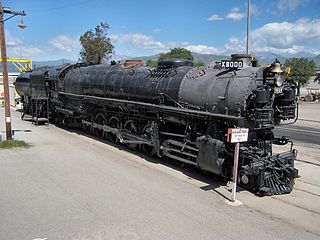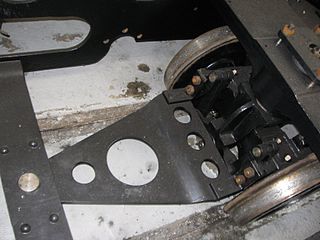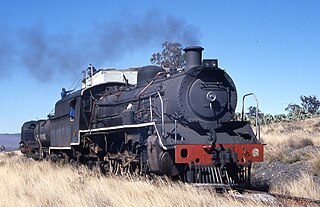
A torsion bar suspension, also known as a torsion spring suspension, is any vehicle suspension that uses a torsion bar as its main weight-bearing spring. One end of a long metal bar is attached firmly to the vehicle chassis; the opposite end terminates in a lever, the torsion key, mounted perpendicular to the bar, that is attached to a suspension arm, a spindle, or the axle. Vertical motion of the wheel causes the bar to twist around its axis and is resisted by the bar's torsion resistance. The effective spring rate of the bar is determined by its length, cross section, shape, material, and manufacturing process.

This article is a glossary of the main components found on a typical steam locomotive.

Under the Whyte notation for the classification of steam locomotives, 4-2-0 represents the wheel arrangement of four leading wheels on two axles, two powered driving wheels on one axle and no trailing wheels. This type of locomotive is often called a Jervis type, the name of the original designer.

The Union Pacific Railroad 9000 Class was a class of 88 steam locomotives, built by ALCO for the Union Pacific between 1926 and 1930.

The Gresley conjugated valve gear is a valve gear for steam locomotives designed by Sir Nigel Gresley, chief mechanical engineer of the LNER, assisted by Harold Holcroft. It enables a three-cylinder locomotive to operate with only the two sets of valve gear for the outside cylinders, and derives the valve motion for the inside cylinder from them by means of levers. The gear is sometimes known as the Gresley-Holcroft gear, acknowledging Holcroft's major contributions to its development.

A Krauss-Helmholtz bogie (Krauss-Helmholtz-Lenkgestell) is a mechanism used on steam locomotives and some electric locomotives to improve curve running.

A Bissell or Bissel truck is a single-axle bogie which pivots towards the centre of a steam locomotive to enable it to negotiate curves more easily. Invented in 1857 by Levi Bissell and usually then known as a pony truck, it is a very simple and common means of designing a carrying wheel.

The Beugniot lever (Beugniot-Hebel) is a mechanical device used on a number of locomotives to improve curve running. It was named after its inventor Édouard Beugniot.

The German Class 41 steam locomotives were standard goods train engines (Einheitslokomotiven) operated by the Deutsche Reichsbahn (DRB) and built from 1937 to 1941.

The Grand Duchy of Mecklenburg Friedrich-Franz Railway grouped early, 2-4-0, passenger train locomotives from the Friedrich-Franz Railway into its Class III.

The Integral Coach Factory (ICF) coach was a conventional passenger coach used on the majority of main-line trains in India. The design of the coach was developed by Integral Coach Factory, Perambur, Chennai, India in collaboration with the Swiss Car & Elevator Manufacturing Co, Schlieren, Switzerland in the 1950s. The design is also called the Schlieren design based on the location of the Swiss company. The 1st ICF coach had been flagged by then Prime Minister Jawaharlal Nehru on 2 October 1955. The last ICF coach was flagged off by senior technician Shri Bhaskar P. in the presence of Railway Board Chairman Ashwani Lohani on 19 January 2018.
The SER 235 class was a class of 0-4-4T steam locomotives on the South Eastern Railway. Introduced in 1866, they were the first locomotives of this wheel arrangement to be built for an English railway.
The Victorian Railways V Class is a steam locomotive, used on the Victorian Railways in the period 1900-1930.

The South African Railways Class 21 2-10-4 of 1937 was a class of steam locomotives used in South Africa.

The South African Railways Class 19B 4-8-2 of 1930 was a steam locomotive.

The South African Railways Class 19A 4-8-2 of 1929 was a steam locomotive.

A return connecting rod, return piston rod or double piston rod engine or back-acting engine is a particular layout for a steam engine.
The locomotives of Class XIX of the Grand Duchy of Mecklenburg Friedrich-Franz Railway were deployed on the Bad Doberan–Heiligendamm narrow-gauge. The triple-coupled engines were classified as T 7 locomotives in 1910. In 1911 they were transferred to the Neubukow Beet Railway.
The Alsace-Lorraine A 3 was a class of German 2-4-0 express passenger locomotives. In 1906 the Imperial Railways in Alsace-Lorraine reclassified them as P 2.
















